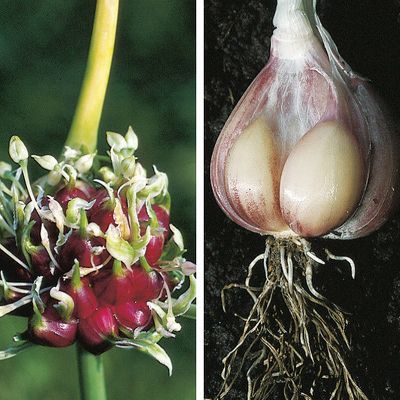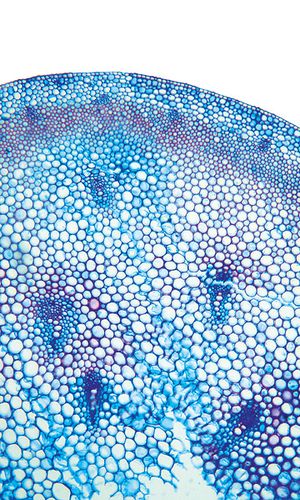Allium sativum L.
1002730
Species
ISFS : 24100
Checklist : 1002730
ISFS : 24100
Checklist : 1002730
Contains :
Synthesis
Species description (© Flora Helvetica 2018)
Zwiebel weisshäutig, mit mehreren (inneren) Nebenzwiebeln. Stängel 30-80 cm hoch, bis zur Mitte beblättert. Blätter lineal, flach, kahl, 4-8(-12) mm breit. Blütenstand halbkugelig, Durchmesser 6-10 cm, reichblütig, aber oft steril und mit Brutzwiebeln. Hüllblatt einseitig, mit langem Schnabel den Blütenstand überragend. Perigonblätter rötlich- oder grünlich-weiss, ca. 3 mm lang. Staubblätter eingeschlossen, die 3 inneren mit kurzen, die Staubbeutel nicht überragenden Seitenzähnen.Flowering period (© Flora Helvetica 2018)
6Habitat and distribution inside Switzerland (© Flora Helvetica 2018)
In vielen Sorten kultiviert und selten verwildert / kollin-montan(-subalpin) /World distribution (© Flora Helvetica 2018)
Stammt aus AsienEcological indicator (© Landolt & al. 2010)
3w43-34+4.g.2n=16Status
IUCN status
flora.fl.National Priority
--International responsibility
--Conservation
Threats
Anatomy
Summary of stem anatomy (German)
Umriss rund oder oval. Leitbündel diffus verteilt. Kleine Interzellularen, oft dreieckig. Epidermiszellen nicht verholzt.Description
Culm-diameter 2-5 mm, center full, radius of culm in relation to wall thickness 1:1. Outline circular with a smooth surface. Culm-center full, containing unlignified cells. Without cortex/cylinder separation. Culm without endodermis but with a sheath of lignified cells around the center. Epidermis smooth. Epidermis-cells thin-walled all around. Large vascular bundles distributed in the whole culm. Small or rudimentary vascular bundles mainly at the periphery. Chlorenchyma present, continuous peripheral belt with unlignified round cells (like a large cortex). Sheath around vascular bundles absent or not lignified. Vessel arrangement radial. Largest vessel in the bundle 20-50 μm. Cavities (intercellulars) between parenchyma-cells small, often triangular.Distribution map
Habitat and distribution inside Switzerland
World distribution
Stammt aus AsienEcology
Life form
Geophyte
Habitats
Milieux Phytosuisse (© Prunier et al. 2017)
Habitats © Delarze & al. 2015
| NO INFORMATION |
bold
Dominant species, influencing the appearance of the habitat
 Character species
Character species
 Less strictly linked to a specific habitat
Less strictly linked to a specific habitat
Ecological indicator values by © Landolt & al. (2010)
| Soil factors | Climatic factors | Salinity tolerance | |||
|---|---|---|---|---|---|
| Humidity Value H | 3w | Light Value L | 3 | Salinity Index | -- |
| Reaction Value R | 4 | Temperature factor T | 4+ | ||
| Nutriments value N | 3 | Continentality K | 4 | ||
- Ecological values legend
Humidity Value H 1 very dry 1+ dry 2 moderatly dry 2+ moist 3 medium wet 3+ wet 4 very wet 4+ soggy 5 submerged or underwater f plants living in running water u mostly submerged plants v partly submerged, partly floating plants w humidity moderately variable (± scale of 1-2) w+ highly variable humidity (scale exceeding ± 2) Reaction Value R 1 Very acid (pH 2.5-5.5) 2 acid (pH 3.5-6.5) 3 lightly acid to neutral (pH 4.5-7.5) 4 neutral to basic (pH 5.5-8.5) 5 basic (pH 6-5 -> 8.5 Nutriments value N 1 very low in nutrients 2 low in nutriments 3 medium-poor to medium-rich in nutrients 4 rich in nutriments 5 very rich in nutriments Salinity tolerance 1 halotolerant 3 halophyle Light Value L 1 very shady 2 shady 3 lighted areas 4 luminous 5 highly luminous Temperature factor T 1 alpine to nival stages (from the treeline to the snowline) 1+ suprasubalpine and upper subalpine levels (pine and larch forests) 2 subalpine level (coniferous forests without beeches up to the upper limit of spruces) 2+ lower subalpine and upper mountain stages 3 mountain level (beech and silver fir forests, in the central Alps Scots pine forests) 3+ lower mountain and upper hill levels 4 hill level (mixed deciduous oak forests) 4+ hot places, hill level 5 very hot places, hill level (only in the hottest places, typical of southern Europe) Continentality K 1 Atlantic (high air humidity, very low temperature variations, mild winters) 2 Sub-Atlantic (high air humidity, low temperature variations, relatively mild winters) 3 sub-Atlantic to subcontinental (average air humidity, moderately variable temperature, slightly low winter temperatures) 4 subcontinental (low air humidity, large temperature variations, rather cold winters) 5 continental (very low air humidity, very large temperature variations, cold winters)
Water dependency
| Rivers | |
| Calm water | |
| Ground water |
Nomenclature
Accepted Name (Checklist 2017)
Allium sativum L.
Vernacular name
Deutscher Name :
KnoblauchNom français :
AilNome italiano :
Aglio comuneMatch with other reference books
| Relation | Nom | Book | No |
|---|---|---|---|
| = | Allium sativum L. | Checklist 2017 | 24100 |
| = | Allium sativum L. | Flora Helvetica 2001 | 2873 |
| = | Allium sativum L. | Flora Helvetica 2012 | 2489 |
| = | Allium sativum L. | Flora Helvetica 2018 | 2489 |
| = | Allium sativum L. | Index synonymique 1996 | 24100 |
| = | Allium sativum L. | SISF/ISFS 2 | 24100 |
= The taxon corresponds to the accepted taxon (Checklist 2017)
< The taxon is included in the accepted taxon (Checklist 2017)
> The taxon includes (among others) also the accepted taxon (Checklist 2017)
< The taxon is included in the accepted taxon (Checklist 2017)
> The taxon includes (among others) also the accepted taxon (Checklist 2017)
Status
Native status
-IUCN list of endangered species (© Walter & Gillett 1997) : No
Status on national Red List
| NO INFORMATION |
National Priority Species List Status
| National Priority | -- |
| Need to take action | -- |
| International responsibility | -- |
| Need to monitor populations | -- |
Protection status
| No international, national or cantonal protection |
- Disclaimer
InfoFlora compiles information on protected species as accurately as possible, taking it from the respective cantonal laws. In some cases, however, it was not possible to use the plant names as listed in the original text, but an interpretation of their taxonomy or nomenclature was necessary. The exact meaning of the categories „completely protected“ and „partially protected“ differs among the cantons.
InfoFlora cannot guarantee that the information on the protection status is correct and complete. In case of doubts, we recommend to look up the texts of the respective cantonal law.
Status by sector of activity
| Agriculture-related environmental objectives : | more informations | |
| Forest management environmental objectives : | more informations |


